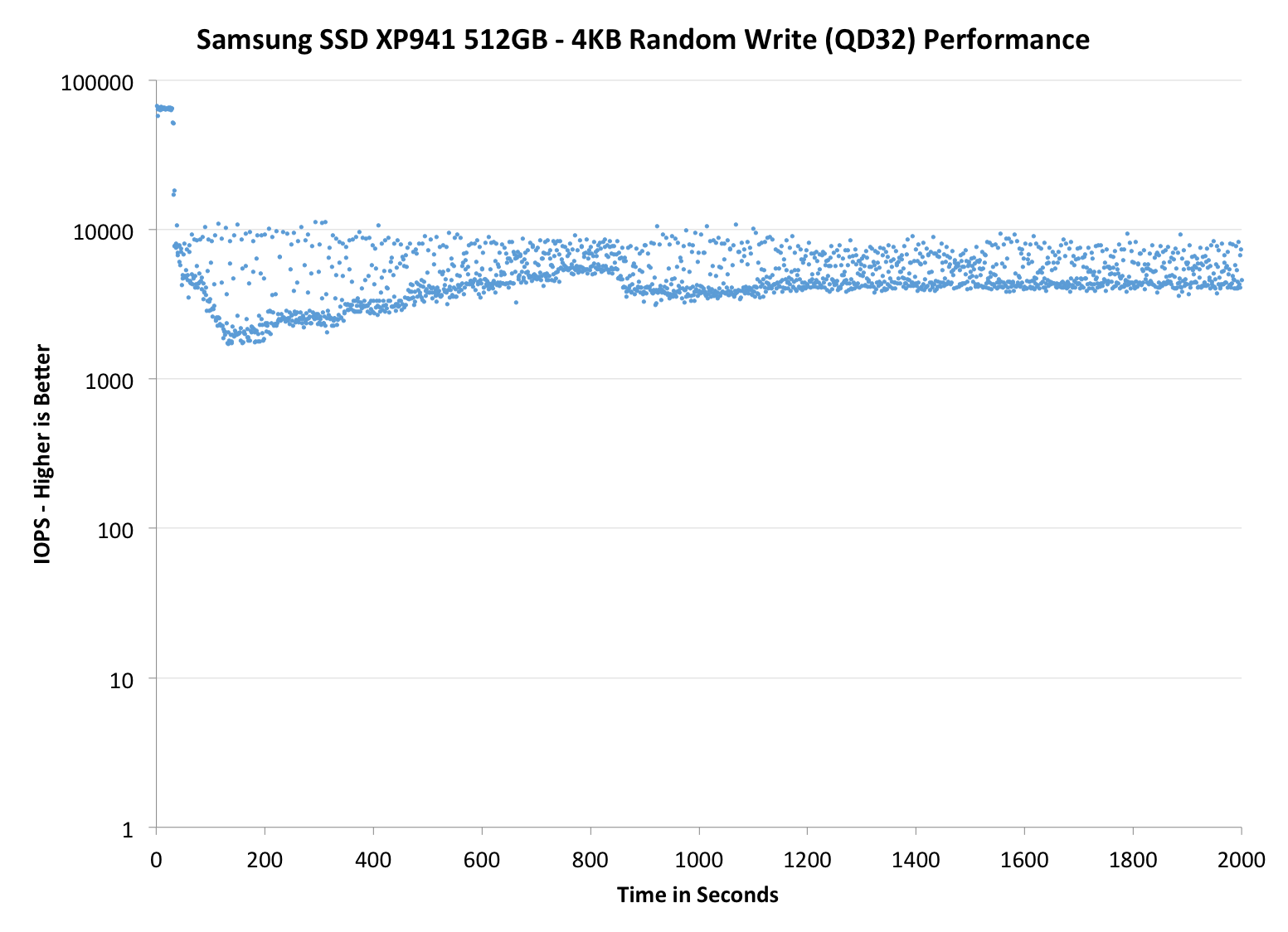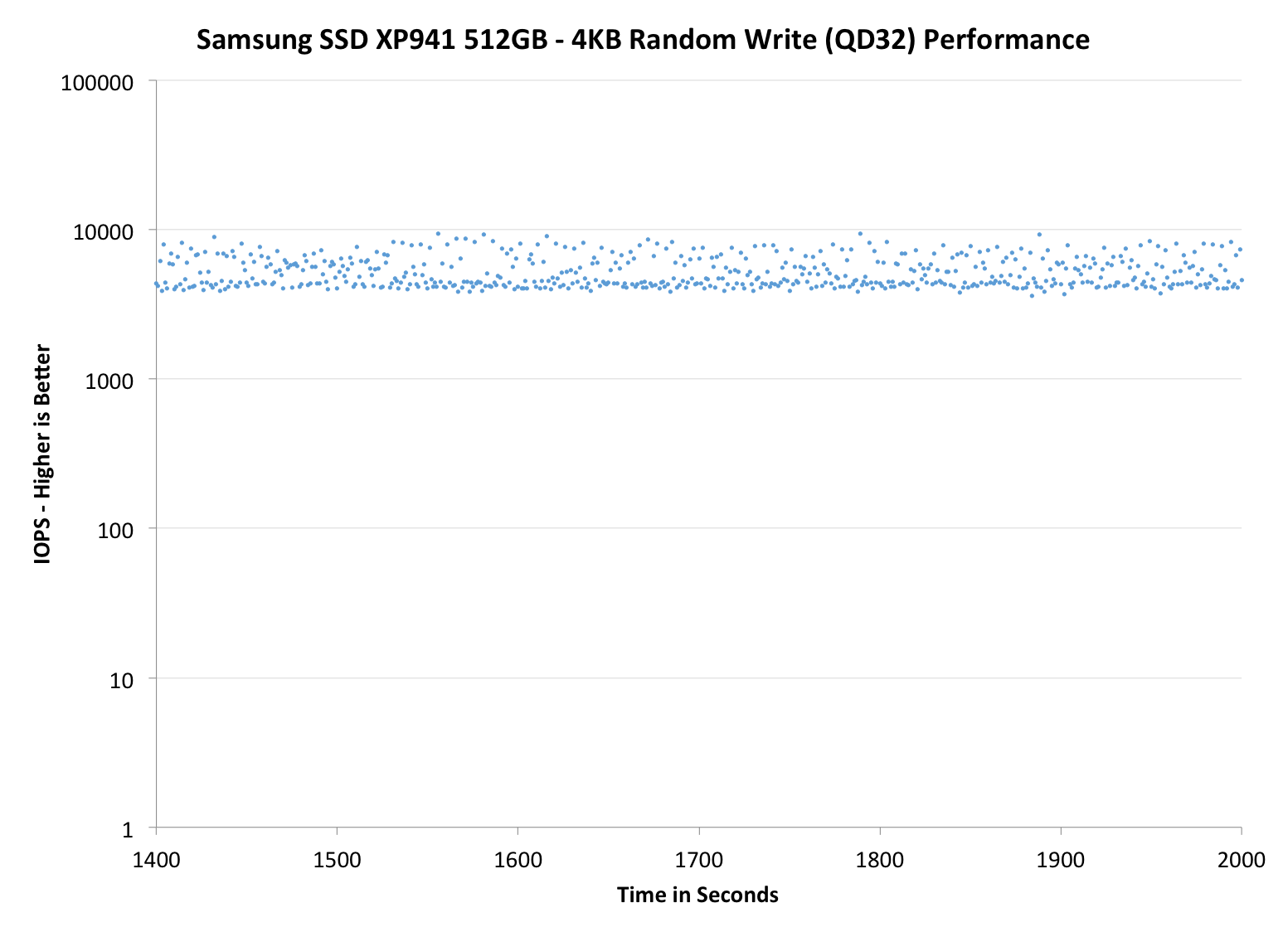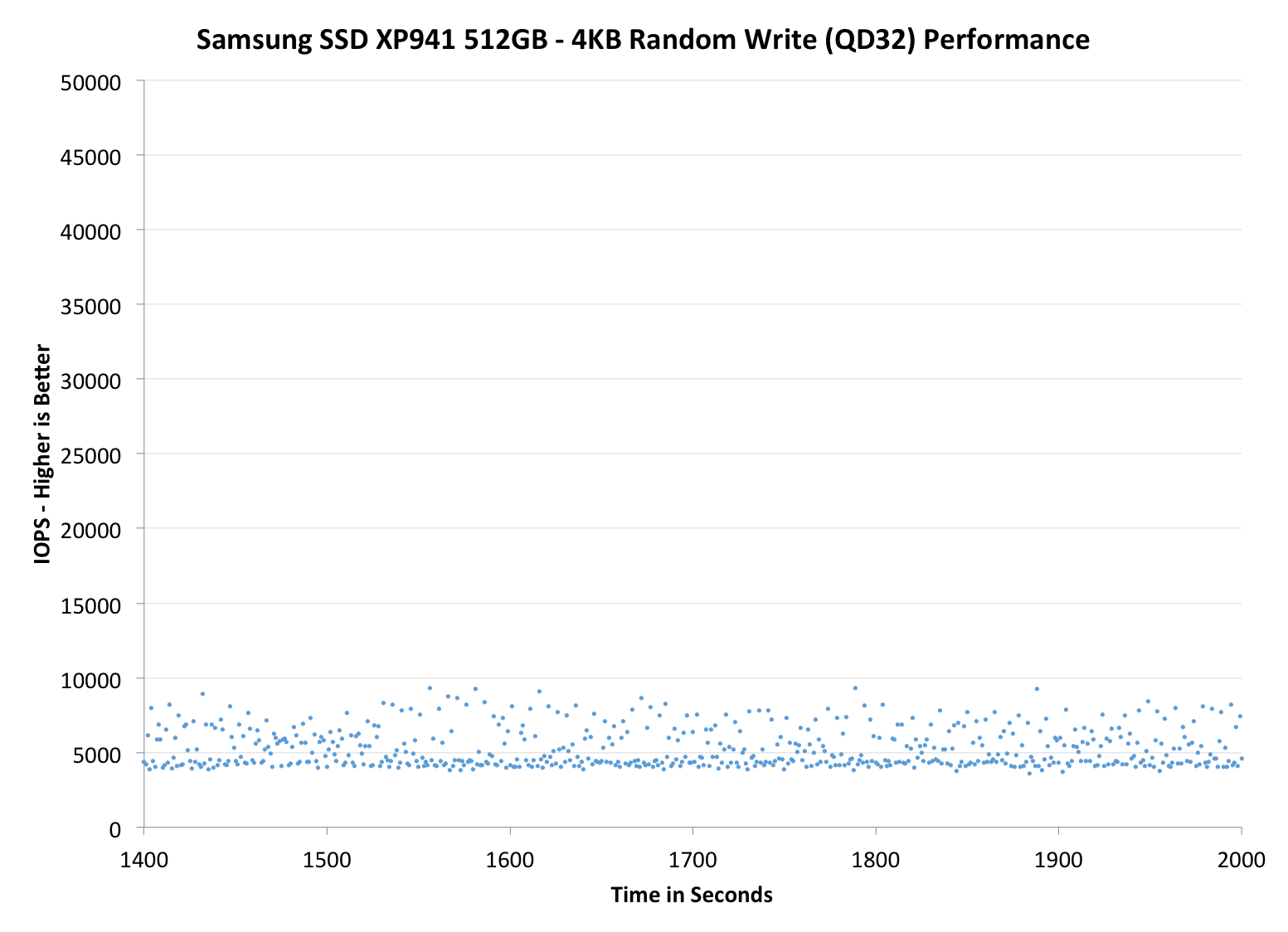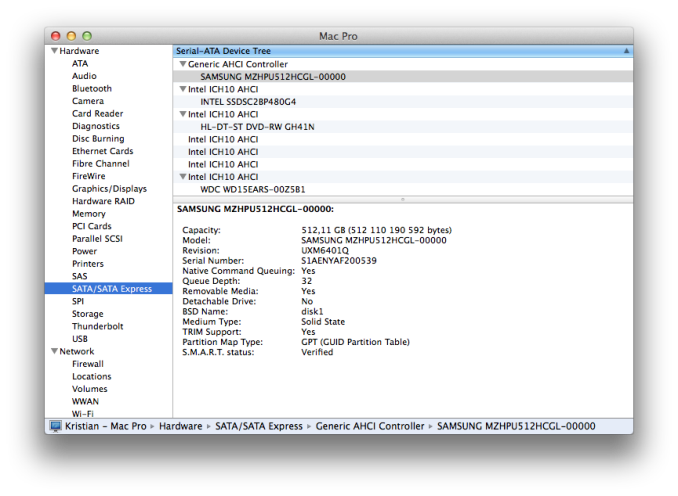Samsung SSD XP941 Review: The PCIe Era Is Here
by Kristian Vättö on May 15, 2014 12:00 PM ESTPerformance Consistency
Performance consistency tells us a lot about the architecture of these SSDs and how they handle internal defragmentation. The reason we don’t have consistent IO latency with SSD is because inevitably all controllers have to do some amount of defragmentation or garbage collection in order to continue operating at high speeds. When and how an SSD decides to run its defrag or cleanup routines directly impacts the user experience as inconsistent performance results in application slowdowns.
To test IO consistency, we fill a secure erased SSD with sequential data to ensure that all user accessible LBAs have data associated with them. Next we kick off a 4KB random write workload across all LBAs at a queue depth of 32 using incompressible data. The test is run for just over half an hour and we record instantaneous IOPS every second.
We are also testing drives with added over-provisioning by limiting the LBA range. This gives us a look into the drive’s behavior with varying levels of empty space, which is frankly a more realistic approach for client workloads.
Each of the three graphs has its own purpose. The first one is of the whole duration of the test in log scale. The second and third one zoom into the beginning of steady-state operation (t=1400s) but on different scales: the second one uses log scale for easy comparison whereas the third one uses linear scale for better visualization of differences between drives. Click the buttons below each graph to switch the source data.
For more detailed description of the test and why performance consistency matters, read our original Intel SSD DC S3700 article.
 |
|||||||||
| Samsung SSD XP941 | Plextor M6e | Samsung SSD 840 Pro | SanDisk Extreme II | Samsung SSD 840 EVO mSATA | |||||
| Default | |||||||||
| 25% Spare Area | |||||||||
The interface has never been the bottleneck when it comes to random write performance, especially in steady-state. Ultimately the NAND performance is the bottleneck, so without faster NAND we aren't going to see any major increases in steady-state performance.
The graphs above and below illustrate this as the XP941 isn't really any faster than the SATA 6Gbps based 840 Pro. Samsung has made some tweaks to their garbage collection algorithms and overall the IO consistency gets a nice bump over the 840 Pro but still, this is something we've already seen with SATA 6Gbps SSDs. I wouldn't say the IO consistency is outstanding because the Plextor M6e does slightly better with the default over-provisioning (both drives have ~7%) but if you increase the over-provisioning the XP941 will show its magic.
 |
|||||||||
| Samsung SSD XP941 | Plextor M6e | Samsung SSD 840 Pro | SanDisk Extreme II | Samsung SSD 840 EVO mSATA | |||||
| Default | |||||||||
| 25% Spare Area | |||||||||
 |
|||||||||
| Samsung SSD XP941 | Plextor M6e | Samsung SSD 840 Pro | SanDisk Extreme II | Samsung SSD 840 EVO mSATA | |||||
| Default | |||||||||
| 25% Spare Area | |||||||||
TRIM Validation
Update 5/20: I got an email from one of our readers suggesting that the TRIM issue might be related to Windows 7 and that Windows 8 should have functioning TRIM for PCIe SSDs. To try this, I installed Windows 8.1 to a secondary drive and ran our regular pre-conditioning (fill with sequential data and torture with 4KB random write for 60 minutes). To measure performance, I had to rely on Iometer as HD Tach didn't work properly under Windows 8. I ran the same 128KB sequential write test that we usually run (QD=1, 100% LBA) but extended the length to 10 minutes to ensure that the results are steady and not affected by burst performance.
| Samsung SSD XP941 512GB - Iometer 128KB Sequential Write (QD1) | ||
| Clean | After TRIM | |
| Samsung SSD XP941 512GB | 607.7 MB/s | 598.9 MB/s |
And TRIM seems to function as it should, so it indeed looks like this is just a Windows 7 limitation, which is excellent news.
------------------------
To test TRIM, I took a secure erased XP941 and filled it with sequential data, followed by a 60-minute torture with 4KB random writes (QD32). After the torture, I TRIM'ed all user-accessible LBAs and ran HD Tach to produce the graph below:
It looks like TRIM isn't functional, although I'm not that surprised. I'm waiting to hear back from Samsung about whether this is a limitation in the operating system because I've heard that Windows doesn't treat PCIe drives the same even if they utilize the same AHCI software stack like the XP941 does. If that's true, we'll need either updates to Windows or some other solution.
In a Mac TRIM support is listed as "yes" when TRIM is enabled for third party drives using TRIM Enabler, though I didn't have the time to verify if it actually works.












110 Comments
View All Comments
BMNify - Thursday, May 15, 2014 - link
"They still do[es] not have one for PCIe-based Macs"so, just get the pci-e card above and use that or even a generic pcie to pci converter and you can install them in your PPC mac, and other systems too, weather they would be accessible booting anything other than a linux PPC distro is another matter OC
Penti - Thursday, May 15, 2014 - link
Macs with PCIe-based SSD's, obviously you could run a discrete PCIe-card (SSD) in a Mac Pro (but that would be SATA/RAID-based not PCIe). PCIe AHCI-based SSD's are only available directly from Apple and made by Samsung and Sandisk, and is only used in recent MBAir, MBP 13/15 and new Mac Pro as well as recent iMacs. There are no third party solutions yet. For previous generations there are solutions and before their own SATA-card SSD they used 2.5-inch drives everywhere except in the Airs. For the 2008/2009 MBA with 1.8-inch drives there are solutions available too. At PowerPC based macs you have either SATA or IDE natively. They just haven't figured out how to produce a PCIe-based SSD for the Macs yet. Over at OWC or anywhere else.RamCity - Thursday, May 15, 2014 - link
Just in case this part was missed in the review here, the XP941 is widely compatible (when installed with an adapter) in the pre-2013 Mac Pro's - all the way back to the 2006/2007 models. The Barefeats.com review is worth a look if you want more information.http://barefeats.com/hard183.html
Penti - Friday, May 16, 2014 - link
The thing I was referring too is that it's not compatible and neither has any compatible modules been made yet for the PCIe-based SSD's of the newer Macs. While earlier SATA-based Apple-custom cards had third party solutions that worked. XP941 is obviously used with a early 2009 Mac Pro with boot-support in the review. So we have number right here. PPC-based systems wouldn't boot it however, even if you might get a Linux-system to recognize it. Which is so far off topic that it's incredible.Penti - Friday, May 16, 2014 - link
Obviously when they have figured out the new connector from Apple the PCIe based controllers should run fine over there on third party cards. Now they just don't exist yet. Like for the thread starters MacBook Pro.Penti - Friday, May 16, 2014 - link
And a early 2013 MBP with SATA-based SSD can use after market SSD's, but not the ones with PCIe yet.Hrel - Thursday, May 15, 2014 - link
256GB SSD, about $100. This one is over $300. Increased speed is nice, but it doesn't matter until they can do it at a better price, closer to the SATA prices the better.I'd be willing to be an early adopter at $200, but I couldn't recommend it to most people until it dropped to $100. I've only recently been able to start recommending SATA SSD's to normal people who don't obsess over every new computer tech.
MrSpadge - Thursday, May 15, 2014 - link
Yeah.. at 3 times the price you'd be far better off using 2 or 3 regular SSDs in RAID - unless you don't have the space and SATA slots for that, like in a mobile workstation.Babar Javied - Thursday, May 15, 2014 - link
Remember when SSDs first came out? they were expensive. But they steadily came down in price and I am sure this will too in due time. Keep in mind that this is new tech and bond to be expensive at first... hell, there is isn't even proper support for it yet.JoyTech - Thursday, May 15, 2014 - link
The benchmark tests only lists results for 512 GB version of Samsung SSD XP941. Are the results same for 256 GB and 128 GB? It is really confusing that this article and previous ones, don't provide those results!